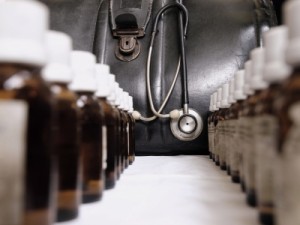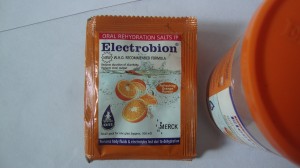
Enlarge George Heyer/Three Lions/Getty Images
A nurse burps a baby after he's been fed, circa 1955. Doctors say that for babies with extreme reflux, off-label use of heartburn drugs can sometimes help. But frequently changes to the mother's diet can be a simpler fix.
George Heyer/Three Lions/Getty Images
A nurse burps a baby after he's been fed, circa 1955. Doctors say that for babies with extreme reflux, off-label use of heartburn drugs can sometimes help. But frequently changes to the mother's diet can be a simpler fix.
Babies have been crying and spitting up since time immemorial. But these days many parents ask: Isn't there a drug for that?
"Parents come in often demanding medication" says Eric Hassall, a pediatric gastroenterologist at Sutter Pacific Medical Foundation in San Francisco.
Prescriptions for acid-suppressing medicines for infants have increased dramatically. Hassall says some parents have picked up on the idea that heavily advertised medicines for reflux in adults can help fussy babies who spit up a lot.
Â
He documented a 16-fold increase in prescriptions of one proton pump inhibitor, or PPI, Prevacid, which comes in a child-friendly formulation. A Food and Drug Administration review also found an 11-fold increase in number of new prescriptions dispensed between 2002 and 2009.
These medicines aren't approved for infants with reflux, or GERD. Still, some doctors have been prescribing them off-label anyway. Doctors generally agree this practice is OK when babies really need the medicine, such as when they're spitting up so much they're not gaining weight.
"The great majority of infants spit up and cry" says Hassall. "But very, very few of them actually have reflux disease and deserve medication." Hassall has researched the effectiveness of the drugs and he has received clinical study grants from AstraZeneca, the maker of the popular acid-suppressing medicine Nexium.
The results of four clinical trials show that these medicines work no better than a placebo in treating infants with reflux. "My point is that there hasn't been a sudden 16-fold increase in the incidence of reflux disease" says Hassall. "It hasn't suddenly become the scourge of otherwise healthy infants."
Hassall recommends dietary changes to the parents of inconsolable babies who spit up after feedings. This strategy has helped many of his patients, including Tara Cree of Vancouver, B.C., who had a rough go with her daughter.
"She was incredibly irritable" recalls Cree. "There was a lot of crying and it just didn't seem right."
The worst of it came just after breast-feedings. When she described the symptoms to Hassall, he told Cree to change her diet to remove certain proteins from her breast-milk.
"So I eliminated dairy, soy and wheat from my diet," Cree says. It was a radical change, since almost all processed foods include some diary, soy or wheat. But she stuck with it because it was so effective. "By day 3 or 4 [of the diet] she was a different baby," says Cree.
Now, not every baby will get the same relief from a mother's diet change, or by switching to a non-dairy baby formula. But Hassall says it's a good approach to try before turning to medication.
Specialists in pediatric gastroenterology have guidelines to help educate pediatricians and families on the treatment of reflux. "There are infants who do benefit from these drugs." says Benjamin Gold, a gastroenterologist in Atlanta, Ga., who has been a paid consultant to AstraZeneca. "It's a small proportion," he says.
But he says with all the discussion about the escalation in prescriptions, he says he doesn't want parents to get the wrong message. "We have to be careful that we don't swing the pendulum back the other way by saying, 'Oh, these drugs are all bad.' "
Gold says what's needed are better diagnostic tools to determine which babies truly need the medicine â€" and that will require more research. For now, he says sometimes you have to try a baby on the medicine.
"The problem is we can't determine [in advance] which children are going to benefit and which are not," Gold says.
Advisers to the FDA have been looking at this issue. They say the limited data in infants suggest the medicines are fairly safe, but there are reports of intestinal inflammation and one study found a slightly increased risk of pneumonia.
The upshot, according to the their review, is that the medicines should be reserved for infants who've been diagnosed with serous problems, such as erosive esophagitis â€" a condition that afflicts relatively few babies.
 Vitamins are the group of organic compounds that can not be synthesized by our body but are essential for our body and must be supplied in the diet (exceptions are vitamin D is synthesized in our skin when exposed to sunlight and small and insufficient quantity of vitamin K is synthesized in the intestine by intestinal flora). Vitamins can not be synthesized but are essential nutrients for us. Vitamins are required by us in very small quantity and fall in the category of micronutrients.
Vitamins are the group of organic compounds that can not be synthesized by our body but are essential for our body and must be supplied in the diet (exceptions are vitamin D is synthesized in our skin when exposed to sunlight and small and insufficient quantity of vitamin K is synthesized in the intestine by intestinal flora). Vitamins can not be synthesized but are essential nutrients for us. Vitamins are required by us in very small quantity and fall in the category of micronutrients.


 Enlarge Jeff Barnard/AP
Enlarge Jeff Barnard/AP  Health insurance doesn’t have to be expensive, and there are policies out there to suit all needs and budgets. Here are five important reasons why you should always shop around for a UK health insurance policy.
Health insurance doesn’t have to be expensive, and there are policies out there to suit all needs and budgets. Here are five important reasons why you should always shop around for a UK health insurance policy. Enlarge iStockphoto.com
Enlarge iStockphoto.com  Prediabetes is a condition where blood glucose level is higher than normal but not high enough to diagnose it as diabetes. Studies has shown that majority of prediabetics develop type-2 diabetes within 10 years. It is therefore important to find out if you are prediabetics, because it is possible to delay/prevent development of type-2 diabetes if proper preventive measures are taken.
Prediabetes is a condition where blood glucose level is higher than normal but not high enough to diagnose it as diabetes. Studies has shown that majority of prediabetics develop type-2 diabetes within 10 years. It is therefore important to find out if you are prediabetics, because it is possible to delay/prevent development of type-2 diabetes if proper preventive measures are taken.
 Vitamin A is widely distributed among animal and plant sources of our food. In animal foods vitamin A is present as preformed vitamin A (retinol) and in plant foods vitamin A is present as provitamin (carotenes, such as beta carotene).
Vitamin A is widely distributed among animal and plant sources of our food. In animal foods vitamin A is present as preformed vitamin A (retinol) and in plant foods vitamin A is present as provitamin (carotenes, such as beta carotene). Enlarge Keith Weller/Courtesy of Johns Hopkins Medicine
Enlarge Keith Weller/Courtesy of Johns Hopkins Medicine  Discovery of ORS (oral rehydration salt or solution) is one of the greatest discoveries in the field of medical science in recent time. It has saved (still saving and will continue to save) more lives than any other medicine (e.g. penicillin). Discovery of penicillin is considered one of the greatest discoveries of medical science, but simple ORS has saved more lives than penicillin. Every year ORS is saving millions of lives (infants, children and adults alike) around the world, especially in developing countries.
Discovery of ORS (oral rehydration salt or solution) is one of the greatest discoveries in the field of medical science in recent time. It has saved (still saving and will continue to save) more lives than any other medicine (e.g. penicillin). Discovery of penicillin is considered one of the greatest discoveries of medical science, but simple ORS has saved more lives than penicillin. Every year ORS is saving millions of lives (infants, children and adults alike) around the world, especially in developing countries. Enlarge George Heyer/Three Lions/Getty Images
Enlarge George Heyer/Three Lions/Getty Images